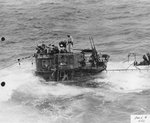GrauGeist
Generalfeldmarschall zur Luftschiff Abteilung
Both my Mom's older brothers served with the USN in the Pacific, one aboard Destroyers, the other (mentioned above) served aboard Subs. My Uncle Fred, the submariner survived his sub being sunk and never had an issue with Japanese. My other Uncle had his destroyer sunk during the battle of the Solomons and later survived kamikaze attacks aboard other destroyers. He, unlike his older brother, disliked anything Japanese for the rest of his life.The weird thing is he held no rancor for the Germans. When he joined the U.S.N. and was subjected to kamikaze attacks, but wasn't sunk, he held a hatred for all things Japanese until the end of his days.
Go figure.....


